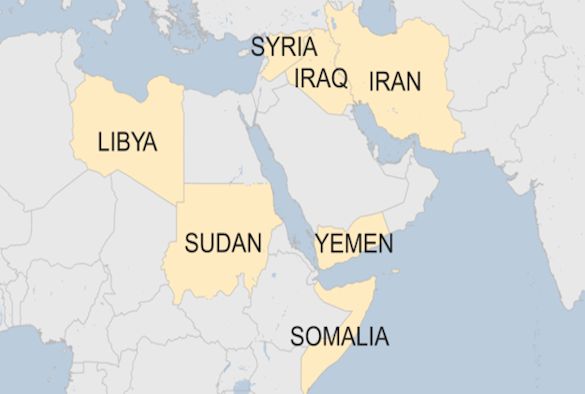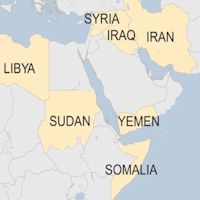
Dr Gaetano Pentassuglia is a Reader in International Law and Human Rights at the University of Liverpool’s School of Law and Social Justice:
“The latest of a raft of measures adopted by US President Donald Trump only a few days after he was sworn into office, the executive order on immigration has sparked heavy criticism in the country and around the world.
The measure is intended primarily to suspend the national refugee system temporarily, and the Syrian refugees programme indefinitely, and to deny entry to the US to individuals from seven named, majority-Muslim countries (Iran, Iraq, Libya, Somalia, Sudan, Syria, and Yemen) for 90 days.
The order has caused a great deal of uncertainty over its practical scope, and above all, its very legality. A number of federal judges have issued injunctions prohibiting individuals who were detained at US airports from being sent back to their country of origin, at least in the case of holders of valid visas or lawful permanent residents.
Crucially, a federal judge in Seattle, in the state of Washington, has issued a nationwide temporary restraining order on President Trump’s key aspects of the measure (particularly the three pillars of it mentioned above), pending the full hearing of the case brought by Washington and Minnesota against the order.
An appeal to it by the US Justice Department was rejected. It remains unclear the extent to which dual-nationals who are citizens of the named countries or who were born there or have family ties in those countries, and who are in principle subject to the ban, will still gain entry into the US over the next few weeks and months on a case-by-case basis depending on perceived security threats or political alliances with other states. Aside from the practical issues related to the executive order, fundamental concerns have been raised that the travel ban falls foul of immigration laws, the Constitution, as well as international human rights obligations undertaken by the US.
It is for the American courts to assess the situation as it unfolds and new lawsuits are filed (over a dozen of them so far). It is entirely possible that the issue will be put to the Supreme Court further down the line. The signs are that some measure of judicial scrutiny is likely to intensify and to show reluctance to endorse the terms of the order, either in full or in part.
From a global human rights perspective, there are at least two issues that come into clear view. One is the 1951 UN Convention on the Status of Refugees and its 1967 Protocol. The other is the broader question of discrimination on grounds of nationality and religion.
While the definition of a ‘refugee’ within the scope of the Convention is fairly established, it is generally accepted that the 1951 regime requires that signatory states set up a procedure for determining whether an asylum-seeker fulfils the conditions laid down in the Convention for refugee status, if only for declaratory purposes.
Crucially, states are not allowed to return refugees (including asylum-seekers) to territories where there is a risk that their lives or freedom would be threatened on account of their race, religion, nationality, membership of a particular social group, or political opinion. Under international human rights law there exists an even broader prohibition of non-refoulement, extended to all individuals at risk of torture or other inhuman or degrading treatment.
To the extent that the travel ban affects asylum-seekers, President Trump’s executive order does not seem to have made space either for a fair procedure for assessing the individual’s status or a duty to refrain from returning individuals to the war zones they come from.
Moreover, given the sweeping nature of the ban, it is highly unlikely that the deportations on security grounds allowed by the order meet the stringent parameters of the Convention (and indeed domestic law) used to exceptionally justify the expulsion on that basis. For example, has the Trump administration provided any rigorous and compelling evidence of a terrorist threat to US nationals at this time, particularly from the seven named Muslim-majority countries?
Tellingly, the order does exempt from the ban, on a case-by-case basis, refugee claims from members of religious minorities who are persecuted in their country of origin (a prioritisation which is due to remain in place after the ban is lifted).
Coupled with the travel ban targeting individuals from named majority-Muslim countries, this exemption effectively allows national agencies to discriminate in the operation of the refugee regime on the ground of religion. As the exemption is expected to overwhelmingly favour Christians over Muslims, it directly violates the principle of non-discrimination, a fundamental part of the very structure of the UN Convention and a principle widely regarded as mandated by general international law.
Although the order mentions neither the Muslim nor the Christian faiths, it can still be argued that the travel ban and its exemptions generate at least indirect discrimination (as opposed to direct or intentional one). Along with several other legal regimes, international human rights law broadly endorses the concept by rejecting national measures which, though neutral on their face, have a disproportionality negative impact on particular sectors of the population.
It seems almost impossible to disentangle Donald Trump’s fiercely anti-Muslim rhetoric during the campaign trail from the order’s distinctions on grounds of nationality and religion. No security measure, not even one enacted in times of emergency, may be permitted to be based on unreasonable and arbitrary distinctions.
The UN High Commissioner for Human Rights has strongly condemned these immigration restrictions, and German Chancellor Angela Merkel has echoed this widely shared sentiment by restating the logic of the 1951 Convention and reminding the United States of its own obligations under the 1967 Protocol. Calling upon a state party to a human right treaty to account for its violations by another party is one way of putting pressure on a non-abiding government.
Criticising another government on human rights grounds is not an action that states take lightly, if they do so at all. Yet, over the next few weeks this initial criticism is more likely to lead to heated exchanges and enhanced scrutiny of the UN human rights system than to any immediate fallout at the highest levels of the international security system, other than confirming an already acute sense of political uncertainty.
In the short term, one central test will be whether the American judicial system will put strains on the executive order, or even pave the way for it to be struck down by the Supreme Court. Will the US’s international obligations inform the judicial reading of national legislation? Will the courts have international human rights treaties override an executive order?
Will the Supreme Court (should it ever be involved) uphold the prohibition of discrimination against Trump’s draconian measures? Federal judges and immigration lawyers may be willing to rise to the challenge, as the Seattle federal judge’s restraining order seems to indicate. However, Trump’s appointment of Neil Gorsuch to the highest court may well tip the balance in favour of conservative readings of the Constitution, shielding the American legal system against external international commitments. It would not be the first time the Supreme Court (or even some lower courts) has done so. Time will tell.
Undeniably, the contested measure will set the stage – legally, politically, and symbolically – for complex debates over nationalism and globalisation, immigration and terrorism, cultural pluralism and cultural dominance.”
